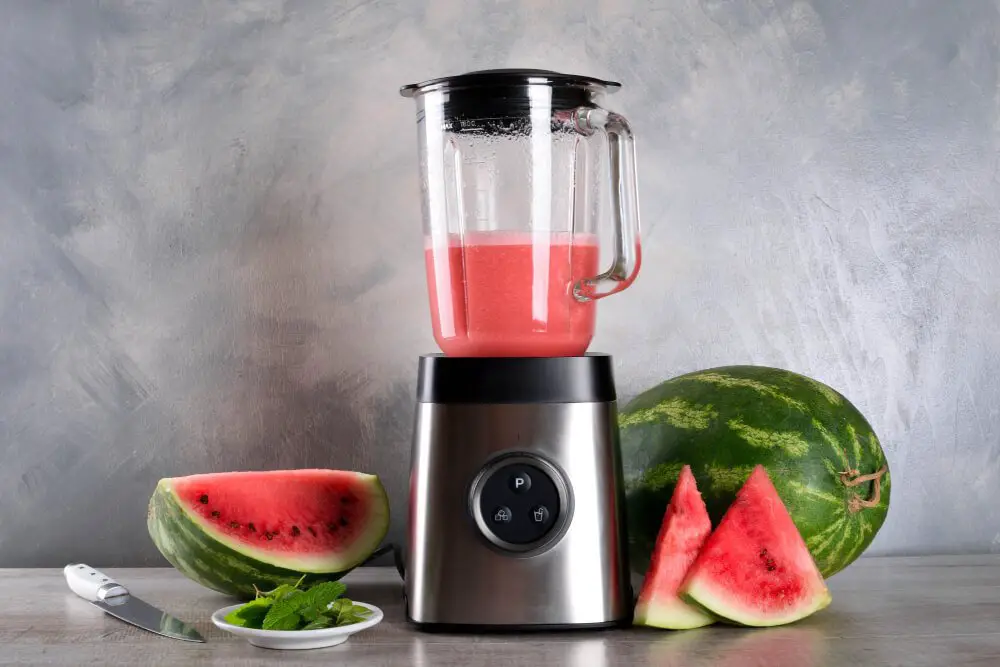Last Updated on August 13, 2023 By Emma W. Thomas
Blenders are loud due to their powerful motors and high-speed blades. They produce sound levels of around 80-95 decibels, comparable to a lawnmower. The blending process creates turbulence and vibrations, contributing to the noise. Manufacturers are working on quieter models with improved sound insulation.
Why Are Blenders So Loud?
Blenders are known for their noisy operation, and several factors contribute to their loudness:
- Motor Power: Blenders have powerful motors that range from 300 to 1500 watts. The higher the wattage, the more forceful the motor, resulting in louder operation.
- High-Speed Blades: Blenders use sharp, high-speed blades to cut through various ingredients efficiently. These blades create turbulence and vibrations, generating noise.
- Aerodynamics: The design of blenders often prioritizes functionality over noise reduction. The blending container’s shape and the airflow around the blades can amplify noise.
- Frequency of Operation: Blenders operate at high speeds, typically ranging from 8,000 to 30,000 revolutions per minute (RPM). Higher RPMs lead to faster blending but also louder noise.
- Lack of Sound Insulation: Many blenders lack proper sound insulation, as reducing noise hasn’t historically been a primary consideration in their design.
- Vibration and Resonance: The combination of high-speed rotation and powerful motors can cause vibration and resonance within the blender’s components, increasing the overall noise level.
- Materials and Construction: Cheaper blenders might use materials that transmit and amplify sound, contributing to the noise. Higher-end blenders often incorporate better sound-dampening materials.
- Manufacturing Costs: Building quieter blenders can increase production costs, impacting the final retail price. This trade-off has led some manufacturers to prioritize motor power and blending performance over noise reduction.
Blenders And Their Noise

Most of us like to wake up to a quiet morning accompanied by our favorite smoothie at the breakfast table. The blender helps us make that smoothie well enough but alas! In the process, the morning loses its tranquility. The general loudness in the blenders becomes even louder due to the vibrations they cause through their counter and inside their walls.
Inside the kitchen, high-power blenders are formidable tools for doing a variety of tasks such as making soup to blend that morning smoothie. They also help us in grinding spices while we prepare our favorite dishes. But with high power comes high levels of volumes, which traditional blenders are experts in making. Many people have gotten used to it and accept that one annoying quality, along with all its uses. But if it really bothers you, then read on to find effective ways of mitigating the sound to some extent by making a few changes.
1. Place The Machine On Top Of A Towel
We usually keep our blenders inside the kitchen above hollow surfaces such as kitchen islands, countertops, and carts. These hollow surfaces act as sound cabinets and create a bassy sound whenever the blender starts functioning and vibrates. This can be taken care of with the help of an easy kitchen hack. Get a clean towel and fold it properly. Keep the folded towel on the hollow surface and place the blender on top of it. This would absorb the sound to a large extent.
It is advisable to use a thick towel as the more the width of the towel, the more sound it can absorb. However, one must be careful to not block vents and necessary airways while using the towel. You can also go with a foam mat or a silicone trivet, which sometimes works better than the kitchen towel and may provide a permanent solution than the latter.
2. Buy Yourself An Enclosure Box
A sound enclosure box is the best way to ensure that your blender doesn’t take your morning quietness away from you. Take notice of the brand and model of your blender and its dimensions and search for a proper enclosure box made of wood, plastic, or even cardboard. If you have the skills for it, you can even dare make one. It would work just as well. Yet, if you can afford a hole in your pocket, then buying the Whisper Blend Sound Enclosure for roughly $200 will do the trick.
3. Keep It Away From Walls
Keeping your blender near a wall can prove to be a fatal mistake as it can multiply the noise levels. The operative noise would reflect off these walls and add to its intensity, making it seem even louder. It is better to place it in the middle of the kitchen counter or the island where it is at least four to six inches apart from the walls. You would find a significant change in the volume levels once you ensure that it is kept apart from any wall.
4. Try Blending The Previous Night
Okay, we know this isn’t exactly a solution to reducing the noise levels of your blender, but it does assure that you aren’t waking your family members in the morning with that god-awful sound. If you can squeeze out 15 minutes the previous evening, just blend that morning smoothie ahead of time and store it in an airtight container. The next morning all you need to do is shake it up a bit and drink it down.
5. Use Ear Muffs
If you are least bothered about others’ sleep and only have your eardrums to save, then the easiest way to tackle blender noise issues is by blocking them with an earmuff. You can use the ear muffs even after you have tried all the other options as a last resort to save your own ears. Buy one that sits comfortably on your ear and blocks most of that sound effectively. You will only be using the blender for a minute or two. Wearing ear-muffs wouldn’t bother you for that long.
5. Buy Noise-Reduced Blenders
This is something you need to do when you have tried everything and are now desperate. There are many blenders available in the market that makers claim to be silent blenders. Vitamix even makes blenders named “The quiet one” priced at a thousand dollars. So if that amount of money is disposable to you, then we recommend going the easier route and opting for silent blenders that might buzz significantly while working but not create a ruckus like the other ones. Keep in mind that this is the most expensive route, as well.
6. Soundproof The Surrounding
This would serve as an extra layer of security so that the sound is absorbed as much as possible inside the room. Affix soundproof foam all along the nearby walls of the blender. This will prevent any echo from those surfaces and prevent any further multiplication of the blender sounds. The installation process is quite easy, as all you need is the help of double-sided tape.
7. Get The Right Blender Combo
The two options you should choose from are the two extremes.
- Either get a blender that is low-powered and low-cost or
- Go the other way and get a high-powered high-cost blender.
Staying in the middle and choosing a low-cost high powered blender will worsen your case.
The best silent blenders in the market
1. Jamba Appliances Quiet Shield Blender
This one is quite elegant in style and quite silent with vibrations. The soundproof enclosure eliminates any disturbances from coming out of it. The compact design also facilitates multiple storages inside it,
2. Optimum High-Speed Blender VAC2
Supported with path-breaking vacuum technology, the Optimum high-speed blender has the advantage of releasing oxygen before blending. As it prevents the entry of oxygen, it preserves all the nutrients of the food inside. It also is one of the best blenders in the market and costs relatively cheaper.
3. Vava 500 Smoothie Blender
If you use your blender mostly for making smoothies and want one that is light on the pocket, Vava 500 takes the cake. The adjustable speed, along with the added presets, make it convenient for the users to make a variety of smoothies using it. It uses a smaller motor and hence is relatively quieter than its competitors.
Top 5 Silent Blenders In The Market
| Blenders | Top Feature |
| Jamba Appliances Quiet Shield blender | Infinite speed control with pulse |
| Vava 500 smoothie blender | Sealed sound enclosure |
| Optimum high-speed blender VAC2 | Temperature sensing probe |
| Blendtec Pro 795 | Advanced sound dampening |
Conclusion
Buying the right blender to suit your needs is an imperative task. But make sure that the blender does not make your neighbors complain is also very important. The steps mentioned above can be of great help in achieving the lowest noise levels from a blender.
References:
https://www.thecoldwire.com/why-are-blenders-so-loud/
https://www.reviewmast.com/why-are-blenders-so-loud/
Emma is a graduate of Domestic Science or Family and Consumer Sciences (Home Economics) from the University of Wisconsin. She has 7 years of experience Working with the strategic section of BestBuy and now writing full-time for Homeeon.
From Managing the Home, Interiors, Cleaning, and Exteriors to Gardening and everything about Making A Home Liveable – is her passion and this Homeeon is the result of this.
Emma loves decorating her home with the best stuff found online. She cares about quality over anything and writes reviews about them here in Homeeon. Get in touch with her over Pinterest.
Keep reading her blogs.

